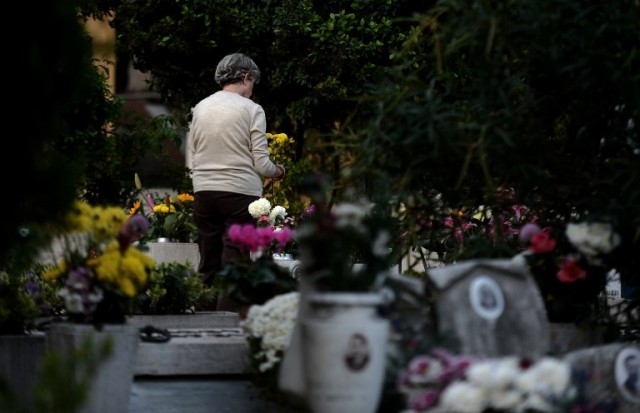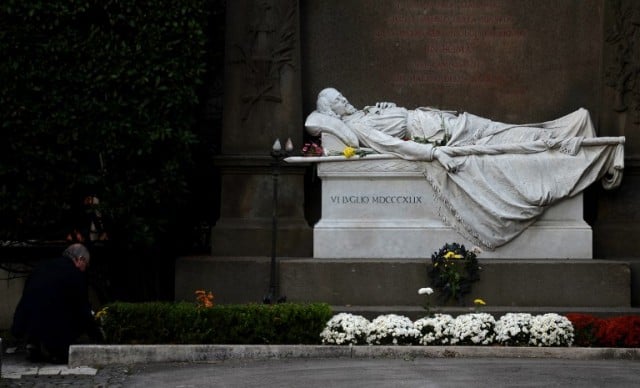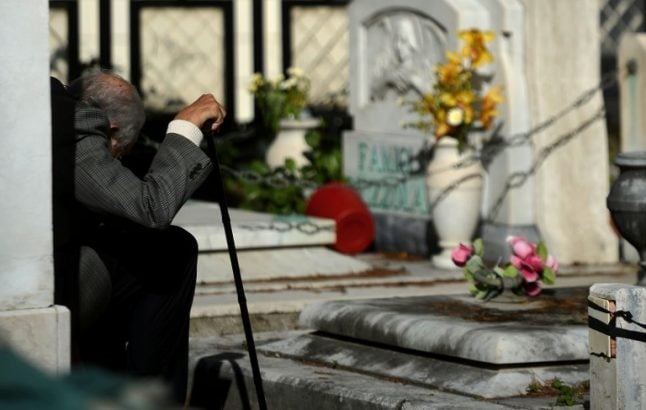They’re all part of Italy’s centuries-old tradition of taking November 2nd to remember the dead. In Italy as in many other Christian countries, the day after All Saints’ Day is All Souls’ Day – and here it’s celebrated with prayers, flowers and, of course, food.
For many Italians, the most important act of remembrance is visiting loved ones’ graves. Cemeteries see an influx of visitors on or around November 2nd, when it’s time to tidy up the family plot and decorate tombs with candles and fresh flowers.
READ ALSO: Why Italy’s All Saints and All Souls days have nothing to do with Halloween
The traditional choice of bloom is brightly coloured chrysanthemums: the autumnal flowers are at their peak around All Souls’ Day and Italians associate them with mourning.
For many people the graveside vigil is an occasion to thank their ancestors, a celebration of their lives and a chance for adults and children alike to chat to them as if they were still here.
In Rome there was even a custom to eat a picnic at the graveside, a way of sharing a meal with dead loved ones.

Visitors to Rome’s Verano cemetery. Photo: Filippo Monteforte/AFP.
If the living get closer to the dead on All Souls’ Day, it’s also the time for the dead to get closer to the living.
Some believe that the spirits of those departed return to earth on this day. To welcome them, one common Italian tradition was to set an extra place at the table or even put out a tray of food for invisible visitors.
READ ALSO: Unlucky for some: Thirteen strange Italian superstitions
In parts of Piedmont, families traditionally go to the cemetery in the evening without clearing the dinner table, so that spirits can come and help themselves without being disturbed.
In other regions people leave lanterns lit and fires burning overnight, while in Cremona in Lombardy it was customary to get up early on All Souls’ Day and make the bed to allow wandering souls to find rest.
Of course, not every family follows the same traditions, and more devout Catholics don’t tend to believe that the spirits of the dead visit on this date at all.

Visitors to Rome’s Verano cemetery. Photo: Filippo Monteforte/AFP.
In Sicily, those who return bring something with them. Children who’ve been good and remembered dead relatives in their prayers all year long are rewarded with gifts of toys and sweets, sometimes hidden around the house on the morning of November 2nd.
Elsewhere it’s customary for the living to give gifts. In Sardinia children go from house to house on All Souls’ Day collecting treats of cakes, nuts and dried fruit in exchange for a prayer for the deceased. And in Emilia Romagna the poor are entitled to “carità di murt”: charity in the name of the dead, in the form of donated food or money.
Fave dei morti from Perugia. Photo: Cantalamessa via Wikimedia Commons.
Italy doesn’t celebrate anything without food, and All Souls’ Day is no exception.
Each region has its own variation on dolci dei morti, sweets of the dead, treats meant to sweeten the bitterness of death. Usually simple white biscuits, they’re typically baked in the form of a bone as an edible memento mori.
Another variation is fave dei morti, beans of the dead, small ground almond cakes in the shape of a bean. They’re sometimes given as gifts between lovers on All Souls’ Day – either as a comfort or a pledge to be faithful “’til death do us part”.
A more savoury tradition is a special stuffed bread seasoned with chilli, which some southern Italians would take to be blessed at All Souls’ Day mass before eating it. The spicy filling was supposed to allow whoever ate it to take on burning punishment on behalf of souls suffering in purgatory, thereby offering them some relief.
This article was originally published in 2017



 Please whitelist us to continue reading.
Please whitelist us to continue reading.
Member comments